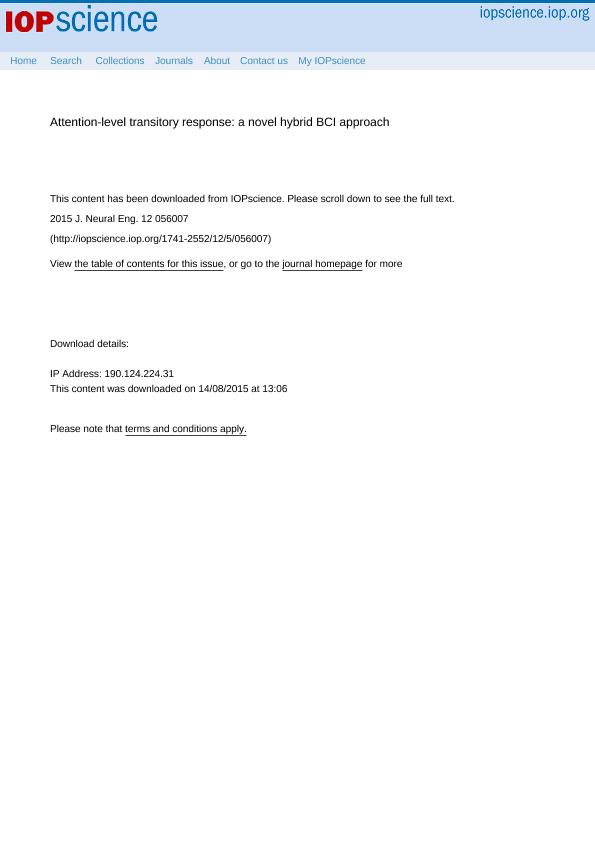Mostrar el registro sencillo del ítem
dc.contributor.author
Diez, Pablo Federico

dc.contributor.author
Garces Correa, Maria Agustina

dc.contributor.author
Orosco, Lorena Liliana

dc.contributor.author
Laciar Leber, Eric

dc.date.available
2018-04-24T19:06:56Z
dc.date.issued
2015-08
dc.identifier.citation
Diez, Pablo Federico; Garces Correa, Maria Agustina; Orosco, Lorena Liliana; Laciar Leber, Eric; Attention-level transitory response: a novel hybrid BCI approach; IOP Publishing; Journal of Neural Engineering; 12; 5; 8-2015; 1-10; 056007
dc.identifier.issn
1741-2560
dc.identifier.uri
http://hdl.handle.net/11336/43306
dc.description.abstract
Objective. People with disabilities may control devices such as a computer or a wheelchair by means of a brain–computer interface (BCI). BCI based on steady-state visual evoked potentials (SSVEP) requires visual stimulation of the user. However, this SSVEP-based BCI suffers from the 'Midas touch effect', i.e., the BCI can detect an SSVEP even when the user is not gazing at the stimulus. Then, these incorrect detections deteriorate the performance of the system, especially in asynchronous BCI because ongoing EEG is classified. In this paper, a novel transitory response of the attention-level of the user is reported. It was used to develop a hybrid BCI (hBCI). Approach. Three methods are proposed to detect the attention-level of the user. They are based on the alpha rhythm and theta/beta rate. The proposed hBCI scheme is presented along with these methods. Hence, the hBCI sends a command only when the user is at a high-level of attention, or in other words, when the user is really focused on the task being performed. The hBCI was tested over two different EEG datasets. Main results. The performance of the hybrid approach is superior to the standard one. Improvements of 20% in accuracy and 10 bits min−1 are reported. Moreover, the attention-level is extracted from the same EEG channels used in SSVEP detection and this way, no extra hardware is needed. Significance. A transitory response of EEG signal is used to develop the attention-SSVEP hBCI which is capable of reducing the Midas touch effect.
dc.format
application/pdf
dc.language.iso
eng
dc.publisher
IOP Publishing

dc.rights
info:eu-repo/semantics/openAccess
dc.rights.uri
https://creativecommons.org/licenses/by-nc-sa/2.5/ar/
dc.subject
Brain Computer Interface (Bci)
dc.subject
False Positive
dc.subject
Midas Touch Effect
dc.subject
Attention-Level Transitory Response
dc.subject
Steady-State Visual Evoked Potential (Ssvep)
dc.subject.classification
Ingeniería de Sistemas y Comunicaciones

dc.subject.classification
Ingeniería Eléctrica, Ingeniería Electrónica e Ingeniería de la Información

dc.subject.classification
INGENIERÍAS Y TECNOLOGÍAS

dc.title
Attention-level transitory response: a novel hybrid BCI approach
dc.type
info:eu-repo/semantics/article
dc.type
info:ar-repo/semantics/artículo
dc.type
info:eu-repo/semantics/publishedVersion
dc.date.updated
2018-04-11T16:01:37Z
dc.journal.volume
12
dc.journal.number
5
dc.journal.pagination
1-10; 056007
dc.journal.pais
Reino Unido

dc.description.fil
Fil: Diez, Pablo Federico. Universidad Nacional de San Juan. Facultad de Ingeniería. Departamento de Electrónica y Automática. Gabinete de Tecnología Médica; Argentina
dc.description.fil
Fil: Garces Correa, Maria Agustina. Universidad Nacional de San Juan. Facultad de Ingeniería. Departamento de Electrónica y Automática. Gabinete de Tecnología Médica; Argentina
dc.description.fil
Fil: Orosco, Lorena Liliana. Universidad Nacional de San Juan. Facultad de Ingeniería. Departamento de Electrónica y Automática. Gabinete de Tecnología Médica; Argentina
dc.description.fil
Fil: Laciar Leber, Eric. Universidad Nacional de San Juan. Facultad de Ingeniería. Departamento de Electrónica y Automática. Gabinete de Tecnología Médica; Argentina
dc.journal.title
Journal of Neural Engineering

dc.relation.alternativeid
info:eu-repo/semantics/altIdentifier/url/http://iopscience.iop.org/article/10.1088/1741-2560/12/5/056007/meta
dc.relation.alternativeid
info:eu-repo/semantics/altIdentifier/doi/http://dx.doi.org/10.1088/1741-2560/12/5/056007
Archivos asociados
